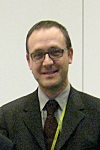
Gabriele Messina
University of Siena, Italy
Title: Environmental contaminants in hospital settings and progress in disinfecting techniques
Biography
Biography: Gabriele Messina
Abstract
Background: Medical devices, such as stethoscopes (ST), and other objects, such as computers keyboards (CK) and telephones handsets (TH) in the hospital, may represent reservoirs of bacteria, possibly determining health-care associated infections (HAIs). Aims of the study were to evaluate microbial contamination of ST, CK and TH pre/post use of a disinfecting technique (DT) and the contamination differences in 4 different units. Materials: We conducted a cross-over study, involving 4 wards of an Italian hospital. We evaluated before/after use of DT the total bacterial count (TBC) at 36°C and 22°C, and several species individually. We analysed 37 TH, 27 CK and 35 ST and compared the contamination between them and 4 hospital wards. Wilcoxon signed-rank and Mann-Whitney tests were used. Results: Before cleaning we found positive samples for Staphylococcus spp. (60% for ST, 83% for TH and 93% for CK), coliforms (43% for ST, 59% for TH and 78% for CK). We also detected some positive samples for MRSA. After DT, the CFUs decreased to zero in most comparisons. First aid ward had the highest contaminations level, while Intensive care the lowest one, with significant difference (P<0.01). CK and TH were significantly more contaminated than ST for TBC at 22°C(P=0.046) and for molds(P=0.002). Conclusion: Objects used during the exercise of clinical professions are source of bacterial contamination. Health care professionals need to be sensitized to disinfect not only stethoscopes but also many objects of common use. Some units, such as first aid, where patients’ turnover is high, should adhere a stricter rules of disinfection.


